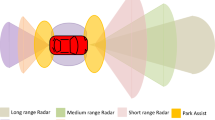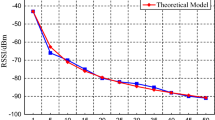Abstract
Autonomous vehicles are going to be used in warehouses or logistic centers more frequently in near future. The location information is vital for autonomous vehicles to accomplish tasks that are assigned to them. This study presents a wireless sensor network to be used in location estimation of autonomous vehicles. The autonomous vehicles estimate their distance to a specific node called as reference anchor node. The aim of the proposed method is to be able get more accurate distance estimations by received signal strength for autonomous vehicles. The proposed wireless sensor network provides sufficient information to the autonomous vehicles to reduce their received signal strength based estimation error. An adaptive filter based algorithm to reduce estimation error is proposed. The performance of the proposed method is validated by simulations and experiments. According to results of the simulations where ideal conditions are provided, maximum error of the proposed method is 0.81m. According to results of the experiments, the average absolute error of the proposed method can be as low as 1.272m. When the proposed method is compared with k-nearest neighbor distance estimation and conventional approach, it has a significantly lower error than them.






















Similar content being viewed by others
Explore related subjects
Discover the latest articles, news and stories from top researchers in related subjects.Data Availability
Enquiries about data availability should be directed to the authors.
References
Durrant-Whyte, H., Pagac, D., Rogers, B., et al. (2007). An autonomous straddle carrier for movement of shipping containers. IEEE Robotics and Automation Magazine, 14(3), 14–24.
Borenstein, J., Everett, H. R., Feng, L., & Wehe, D. (1997). Mobile robot positioning: Sensors and techniques. Journal of Robotic Systems, 14(4), 231–249.
Milanés, V., Naranjo, J. E., González, C., Alonso, J., & de Pedro, T. (2008). Autonomous vehicle based in cooperative GPS and inertial systems. Robotica, 26(5), 627–633.
Jung, C. R., & Kelber, C. R. (2005). Lane following and lane departure using a linear-parabolic model. Image and Vision Computing, 23(13), 1192–1202.
Wang, Y., Teoh, E. K., & Shen, D. (2004). Lane detection and tracking using B-Snake. Image and Vision Computing, 22(4), 269–280.
Gao, Y., Liu, S., Atia, M., & Noureldin, A. (2015). INS/GPS/LiDAR integrated navigation system for urban and indoor environments using hybrid scan matching algorithm. Sensors, 15(9), 23286–23302.
Aldibaja, M., Suganuma, N., & Yoneda, K. (2017). Robust intensity-based localization method for autonomous driving on snow-wet road surface. IEEE Transactions on Industrial Informatics, 13(5), 2369–2378.
Meng, X., Wang, H., & Liu, B. (2017). A robust vehicle localization approach based on gnss/imu/dmi/lidar sensor fusion for autonomous vehicles. Sensors, 17(9), 2140.
Bresson, G., Alsayed, Z., Yu, L., & Glaser, S. (2017). Simultaneous localization and mapping: A survey of current trends in autonomous driving. IEEE Transactions on Intelligent Vehicles, 2(3), 194–220.
Hata, A. Y., & Wolf, D. F. (2015). Feature detection for vehicle localization in urban environments using a multilayer LIDAR. IEEE Transactions on Intelligent Transportation Systems, 17(2), 420–429.
Maneerat, K., & Kaemarungsi, K. (2019). RoC: Robust and low-complexity wireless indoor positioning systems for multifloor buildings using location fingerprinting techniques. Mobile Information Systems, 2019, 5089626. https://doi.org/10.1155/2019/5089626.
Halder, S., & Ghosal, A. (2016). A survey on mobility-assisted localization techniques in wireless sensor networks. Journal of Network and Computer Applications, 60, 82–94.
Alomari, A., Comeau, F., Phillips, W., & Aslam, N. (2018). New path planning model for mobile anchor-assisted localization in wireless sensor networks. Wireless Networks, 24(7), 2589–2607.
Phoemphon, S., So-In, C., & Niyato, D. T. (2018). A hybrid model using fuzzy logic and an extreme learning machine with vector particle swarm optimization for wireless sensor network localization. Applied Soft Computing, 65, 101–120.
Yang, J., Cai, Y., Tang, D., & Liu, Z. (2019). A novel centralized range-free static node localization algorithm with memetic algorithm and Lévy flight. Sensors, 19(14), 3242.
Phoemphon, S., So-In, C., & Leelathakul, N. (2020). A hybrid localization model using node segmentation and improved particle swarm optimization with obstacle-awareness for wireless sensor networks. Expert Systems with Applications, 143, 113044.
Bekcibasi, U., & Tenruh, M. (2014). Increasing RSSI localization accuracy with distance reference anchor in wireless sensor networks. Acta Polytechnica Hungarica, 11(8), 103–120.
Blumenthal, J., Grossmann, R., Golatowski, F., & Timmermann, D. (2007). Weighted centroid localization in zigbee-based sensor networks. In IEEE international symposium on intelligent signal processing.
Goldoni, E., Savioli, A., Risi, M., & Gamba, P. (2010). Experimental analysis of RSSI-based indoor localization with IEEE 802.15. 4. In European Wireless Conference (EW).
Kumar, P., Reddy, L., & Varma, S. (2009). Distance measurement and error estimation scheme for RSSI based localization in Wireless Sensor Networks. In IEEE Fifth international conference on wireless communication and sensor networks (WCSN).
Adewumi, O. G., Djouani, K., & Kurien, A. M. (2013). RSSI based indoor and outdoor distance estimation for localization in WSN. In IEEE international conference on Industrial technology (ICIT).
Mao, G., Fidan, B., & Anderson, B. D. (2007). Wireless sensor network localization techniques. Computer Networks, 51(10), 2529–2553.
Patwari, N., Ash, J. N., Kyperountas, S., Hero, A. O., Moses, R. L., & Correal, N. S. (2005). Locating the nodes: Cooperative localization in wireless sensor networks. IEEE Signal Processing Magazine, 22(4), 54–69.
Bachrach, J. & Taylor, C. (2005). Handbook of sensor networks: Algorithms and architectures. In I. Stojmenovic (Ed.), New Jersey: Wiley. (Chapter 9).
Benkic, K., Malajner, M., Planinsic, P., & Cucej, Z. (2008). Using RSSI value for distance estimation in wireless sensor networks based on ZigBee. In 15th International Conference on Systems, Signals and Image Processing.
URL1, Texas Intruments, Texas, US. CC2538 (datasheet). 33 pages. [Online] Cited 2018-01-20. Available at: http://www.ti.com/lit/ds/symlink/cc2538.pdf
Willis, S. L., & Kikkert, C. J. (2005). Radio propagation model for long-range ad hoc wireless sensor network. In International conference on wireless networks, communications and mobile computing.
Neskovic, A., Neskovic, N., & Paunovic, G. (2000). Modern approaches in modeling of mobile radio systems propagation environment. IEEE Communications Surveys & Tutorials, 3(3), 2–12.
Molisch, A. F., Balakrishnan, K., Cassioli, D., Chong, C. C., Emami, S., Fort, A., ... & Siwiak, K. (2004). IEEE 802.15. 4a channel model-final report. IEEE P802, 15(4), 662.
Seidel, S. Y., & Rappaport, T. S. (1992). 914 MHz path loss prediction models for indoor wireless communications in multifloored buildings. IEEE Transactions on Antennas and Propagation, 40(2), 207–217.
Patwari, N., Hero, A. O., Perkins, M., Correal, N. S., & O’dea, R. J. (2003). Relative location estimation in wireless sensor networks. IEEE Transactions on Signal Processing, 51(8), 2137–2148.
Xu, J., Liu, W., Lang, F., Zhang, Y., & Wang, C. (2010). Distance measurement model based on RSSI in WSN. Wireless Sensor Network, 2(8), 606.
Sari, R., & Zayyani, H. (2018). RSS localization using unknown statistical path loss exponent model. IEEE Communications Letters, 22(9), 1830–1833.
Cama-Pinto, A., Pineres-Espitia, G., Caicedo-Ortiz, J., Ramírez-Cerpa, E., Betancur-Agudelo, L., & Gómez-Mula, F. (2017). Received strength signal intensity performance analysis in wireless sensor network using Arduino platform and XBee wireless modules. International Journal of Distributed Sensor Networks, 13(7), 1550147717722691.
Boban, M., Vinhoza, T. T., Ferreira, M., Barros, J., & Tonguz, O. K. (2010). Impact of vehicles as obstacles in vehicular ad hoc networks. IEEE Journal on Selected Areas in Communications, 29(1), 15–28.
Akhtar, N., Ergen, S. C., & Ozkasap, O. (2014). Vehicle mobility and communication channel models for realistic and efficient highway VANET simulation. IEEE Transactions on Vehicular Technology, 64(1), 248–262.
Dang, X., Hei, Y., & Hao, Z. (2016). An improved indoor localization based on RSSI and feedback correction of anchor node for WSN. In International conference on computer, information and telecommunication systems (CITS).
Singh, A. P., Singh, D. P., & Kumar, S. (2015). NRSSI: new proposed RSSI method for the distance measurement in WSNs. In 1st International conference on next generation computing technologies (NGCT).
Oguejiofor, O., Okorogu, V., Adewale, A., & Osuesu, B. (2013). Outdoor localization system using RSSI measurement of wireless sensor network. International Journal of Innovative Technology and Exploring Engineering, 2(2), 1–6.
Xiao, Z., Wen, H., Markham, A., Trigoni, N., Blunsom, P., & Frolik, J. (2015). Non-line-of-sight identification and mitigation using received signal strength. IEEE Transactions on Wireless Communications, 14(3), 1689–1702.
He, S., & Chan, S. H. G. (2016). Wi-Fi fingerprint-based indoor positioning: Recent advances and comparisons. IEEE Communications Surveys & Tutorials, 18(1), 466–490.
Li, D., Zhang, B., & Li, C. (2016). A feature-scaling-based k-nearest neighbor algorithm for indoor positioning systems. IEEE Internet of Things Journal, 3(4), 590–597.
Luo, R. C., & Hsiao, T. J. (2019). Dynamic wireless indoor localization incorporating with an autonomous mobile robot based on an adaptive signal model fingerprinting approach. IEEE Transactions on Industrial Electronics, 66(3), 1940–1951.
Closas, P., Fernandez-Prades, C., & Fernandez-Rubio, J. A. (2009). Cramér-Rao bound analysis of positioning approaches in GNSS receivers. IEEE Transactions on Signal Processing, 57(10), 3775–3786.
Zhao, Y., Yang, Y., & Kyas, M. (2014). Cramér-rao lower bound analysis for wireless localization systems using priori information. In 11th Workshop on positioning, navigation and communication (WPNC).
Mazuelas, S., Bahillo, A., Lorenzo, R. M., Fernandez, P., Lago, F. A., Garcia, E., & Abril, E. J. (2009). Robust indoor positioning provided by real-time RSSI values in unmodified WLAN networks. IEEE Journal of Selected Topics in Signal Processing, 3(5), 821–831.
Tan, L., & Jiang, J. (2013). Digital signal processing: Fundamentals and applications. Burlington, MA (USA): Academic Press.
URL2, Texas Instruments, Texas, US. CC2538-CC2592 Evaluation Module Kit Quick Start Guide (datasheet). 3 pages. [Online] Cited 2018-03-28. Available at: http://www.ti.com/lit/ml/swru363/swru363.pdf
Suman, K. D., & Pasan, M. K. (2016). Design and methodology of automated guided vehicle-a review. IOSR Journal of Mechanical and Civil Engineering (IOSR-JMCE), 29–36.
Nelson, W. L., & Cox, I. J. (1990). Local path control for an autonomous vehicle. In CoxGordon I. In & J. & Wilfong G.T. (Eds.), Autonomous robot vehicles. New York: Springer.
Ye, C., Jiang, X., Yu, S., & Jiang, C. (2016). A tracking method of an assembling Omni-directional mobile robot. In IEEE International Conference on Robotics and Biomimetics (ROBIO).
Acknowledgements
This study was supported by Karadeniz Technical University Scientific Research Projects Coordination Unit under Grant No: FDK-2016-5410.
Funding
The authors have not disclosed any funding.
Author information
Authors and Affiliations
Corresponding author
Ethics declarations
Conflict of interest
The authors have not disclosed any competing interests.
Additional information
Publisher's Note
Springer Nature remains neutral with regard to jurisdictional claims in published maps and institutional affiliations.
Rights and permissions
About this article
Cite this article
Hacioglu, G., Sesli, E. Improved RSS Based Distance Estimation for Autonomous Vehicles. Wireless Pers Commun 125, 325–350 (2022). https://doi.org/10.1007/s11277-022-09552-x
Accepted:
Published:
Issue Date:
DOI: https://doi.org/10.1007/s11277-022-09552-x




